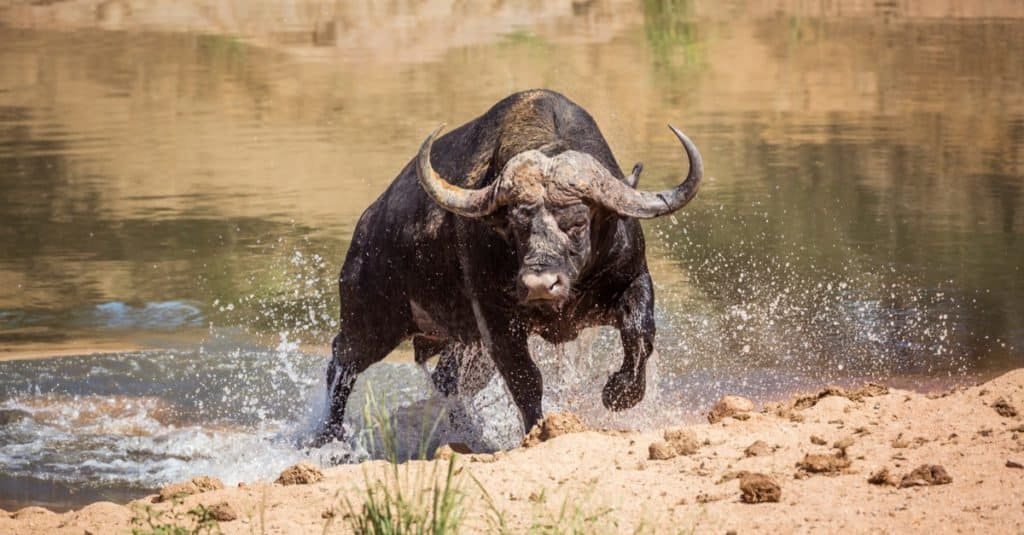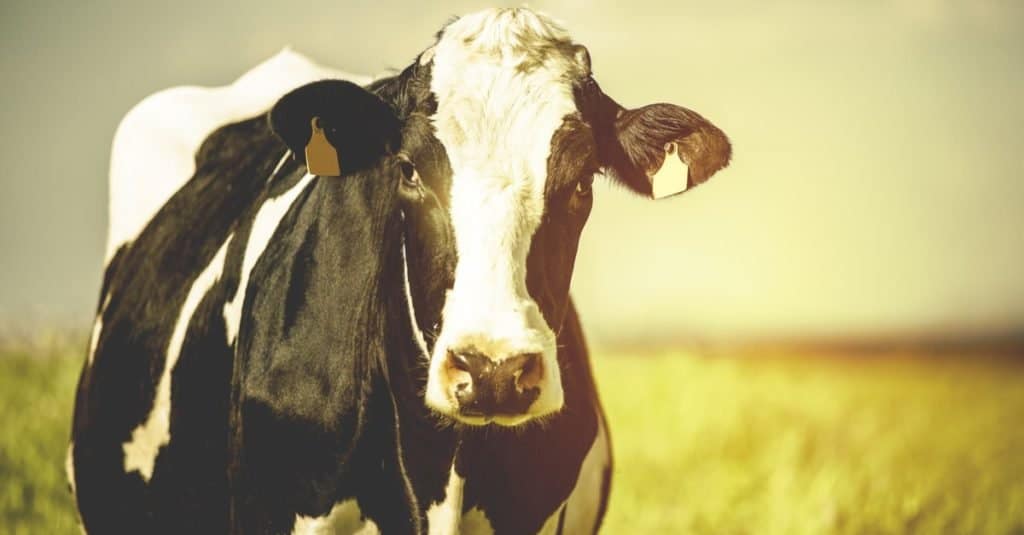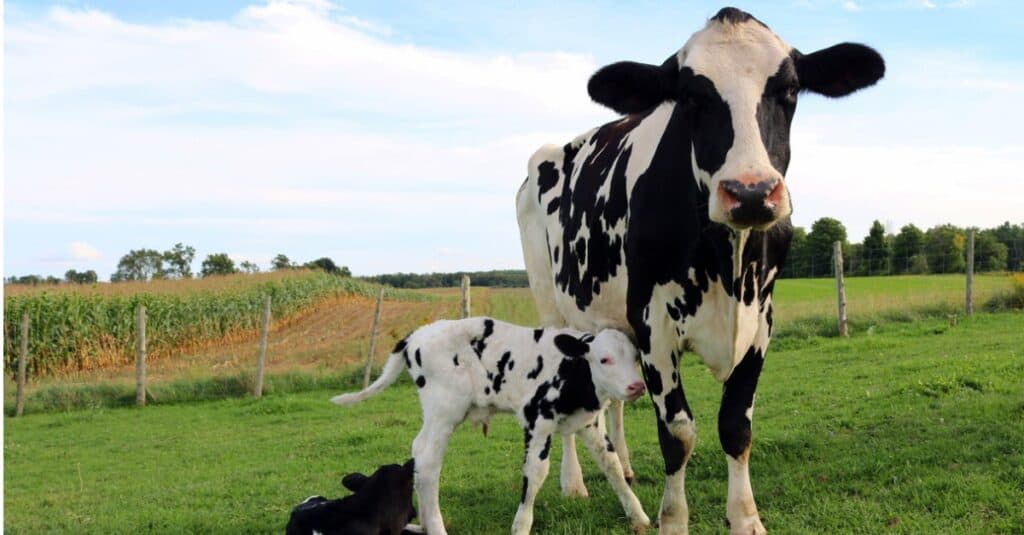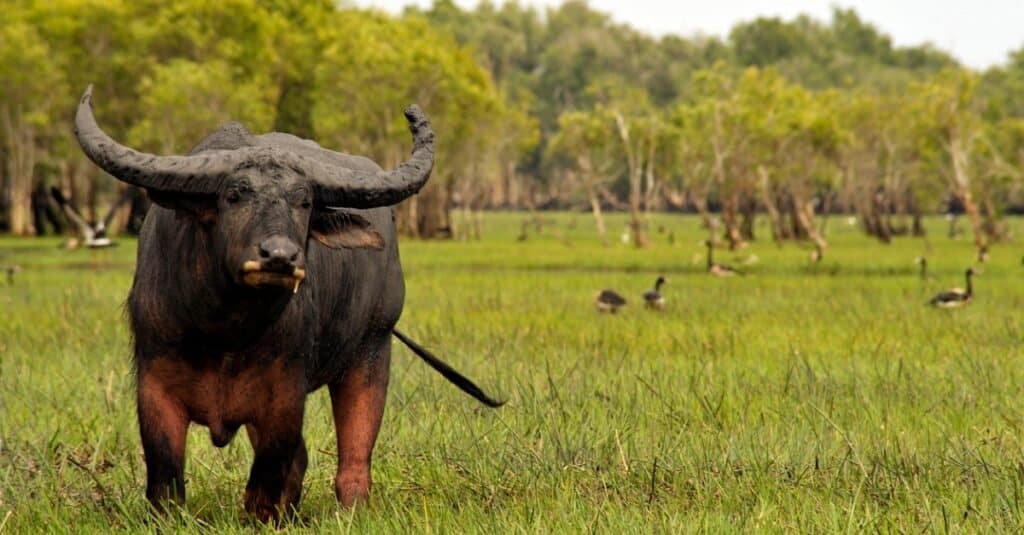Buffaloes and cows seem to have a lot in common. They are both domesticated bovines that have large bodies, horns, and cloven hooves. In fact, both species are also used to produce milk and meat for their human owners, and there are relatively few wild members of their species. So, what are the differences between a buffalo vs cow? We’re going to show you how to differentiate these two creatures by looking at six particular factors. By the time you’re done reading, you’ll know all you need to tell them apart.
Comparing a Buffalo and a Cow

| Buffalo | Cow | |
| Nomenclature | Buffalo refers to a specific, unique species | – Specific meaning is female domesticated cattle that have given birth to calves – Cow is also a term applied to any female bovine species |
| Size | Weight: 1,300lbs – 2,000lbs Height: 3.5ft-5.6ft tall at the shoulder Length: 5ft-6ft | Weight: 880lbs- 1760lbs Height: 4.5-5ft at the shoulder Length: 5ft-6ft |
| Horns | – Long horns – Horns grow horizontally from the head and then curve up and back toward the head | – Short horns – Horns curve up or curve outward immediately |
| Color | Black and gray | White, black, brown, red, and patterned |
| Location | Africa and parts of Asia (Water Buffalo) | Every continent but Antarctica |
| Domestic Uses | African buffalo are not domesticated, but water buffalo in Asia are used for work, meat, and milk | Used for calving, meat, and milk |
The 6 Key Differences Between a Buffalo vs Cow

Cape buffalo are larger and have bigger horns than cows.
©PACO COMO/Shutterstock.com
The greatest differences between a buffalo vs cow lie in their size, horns, and colors. The average buffalo grows larger and taller than the cow, weighing several hundred pounds more.
A buffalo’s horns are long and grow horizontally from the head before curving up and back toward the head. Cow horns are short and curve up or outward as soon as they begin growing.
Buffaloes are black, but their hair starts to become grayer with age. Cows’ hair can be white, black, brown, and red while featuring unique patterns and spots.
These physical differences are the greatest ones that exist between a buffalo and a cow. However, they are not the only differences that exist. Take a closer look at other sorts of differences between these creatures.
Buffalo vs Cow: Nomenclature

Strictly speaking, cows are female domesticated cattle that have had one calf or more.
©David MG/Shutterstock.com
The meaning of the word buffalo is very specific in that it refers to the Syncerus caffer,a species that lives in Africa. The term cow is also specific to female domesticated cattle that have given birth to one calf or more.
However, both “buffalo” and “cow” are used for other creatures. Buffalo is sometimes used to describe the Bubalus Bubalis, also known as the water buffalo or Asian buffalo. Sometimes, the term buffalo is applied to the North American bison, but that animal is most certainly not a true buffalo.
The term cow primarily refers to female domesticated cattle that have had at least one calf. Yet, “cow” is a term that has been routinely applied to any female member of the Bovidae family and has no stipulations on whether it has been bred or not. These other animals are not truly misidentified, but they are not entirely accurate in the face of the existing and specific terminology for buffaloes and cows.
Buffalo vs Cow: Size
Buffaloes are bigger than cows. Buffalo can reach 2,000lbs in weight, stand 5.6ft in height at the shoulder, and grow about 6ft long. Cows grow up to a maximum of 1,700lbs, stand 5ft at the shoulder, and also grow to 6ft long. Thus, buffaloes are larger than cows, and the males of the species are more likely to reach the upper echelons of the ranges we have mentioned.
The heaviest true buffalo weighs almost 2,000lbs, and that honor belongs to the Cape Buffalo in Africa. Yet, some breeds of cattle can surpass this weight and size, but the largest average animal is the buffalo.
Buffalo vs Cow: Horns
Buffaloes have longer and more complex horns than cows. Cows’ horns are short and begin to curve upward and slightly toward one another. Buffaloes’ horns are very long, with males’ horns reaching over 5 feet in length total.
These horns grow horizontally from the mammal’s head and then curve back toward the buffalo’s head, facing outward to be used for defense. They’re very dangerous to the buffalo’s predators, capable of even killing a lion.
Just about all cows have horns, but many of them are cut before they reach adulthood, so they do not interfere in the processes of dairy farming.
Buffalo vs Cow: Color

Although the black and white dairy cow is iconic, they come in many colors.
©iStock.com/Diane Kuhl
Buffaloes are black, but their hair becomes gray with age. Cows can be black, white, brown, red, and other colors. Their hair will sometimes integrate patterns, or it may remain one solid color.
Along with the other factors that we have discussed here, color can be used as a good secondary form of differentiating the creatures.
Buffalo vs Cow: Location
Strictly speaking, buffaloes are from Africa. However, they have cousins that live in Asia, called water buffalo. For our purposes, the primary species of buffalo only live in Africa. Cows live everywhere in the world (excluding Antarctica) as they are one of the most popular sources of meat and milk.
Even if we strip away the definition of cows as being any female bovines, female domesticated cattle still live all over the world.
Buffalo vs Cow: Domestic Uses

Water buffaloes are domesticated, but African buffaloes are not.
©iStock.com/SvdM
Buffaloes are not domesticated in Africa, but water buffalo are used for their meat, milk, and ability to work. Cows are used for breeding and raising calves as well as for their meat and milk. The main difference, including the case of the water buffalo, is that cows are not used for their ability to work. Also, greater numbers of wild buffalo exist than wild cattle.
Another type of animal within the cattle family is used for that, and they are called oxen. Oxen are male cattle that have been castrated and are raised to obey the commands of the farmers for whom they work.
Many differences exist between buffaloes and cows. The two animals are very hard to confuse for one another, though. Their coloration, horns, location, and size make it almost impossible to mistake one for the other. Also, considering their domestic uses, the nomenclature surrounding their names, and locations in the world can clear up any lingering confusion or doubts about which animal is a cow or a buffalo.
The photo featured at the top of this post is © BonnieBC/Shutterstock.com
Thank you for reading! Have some feedback for us? Contact the AZ Animals editorial team.






